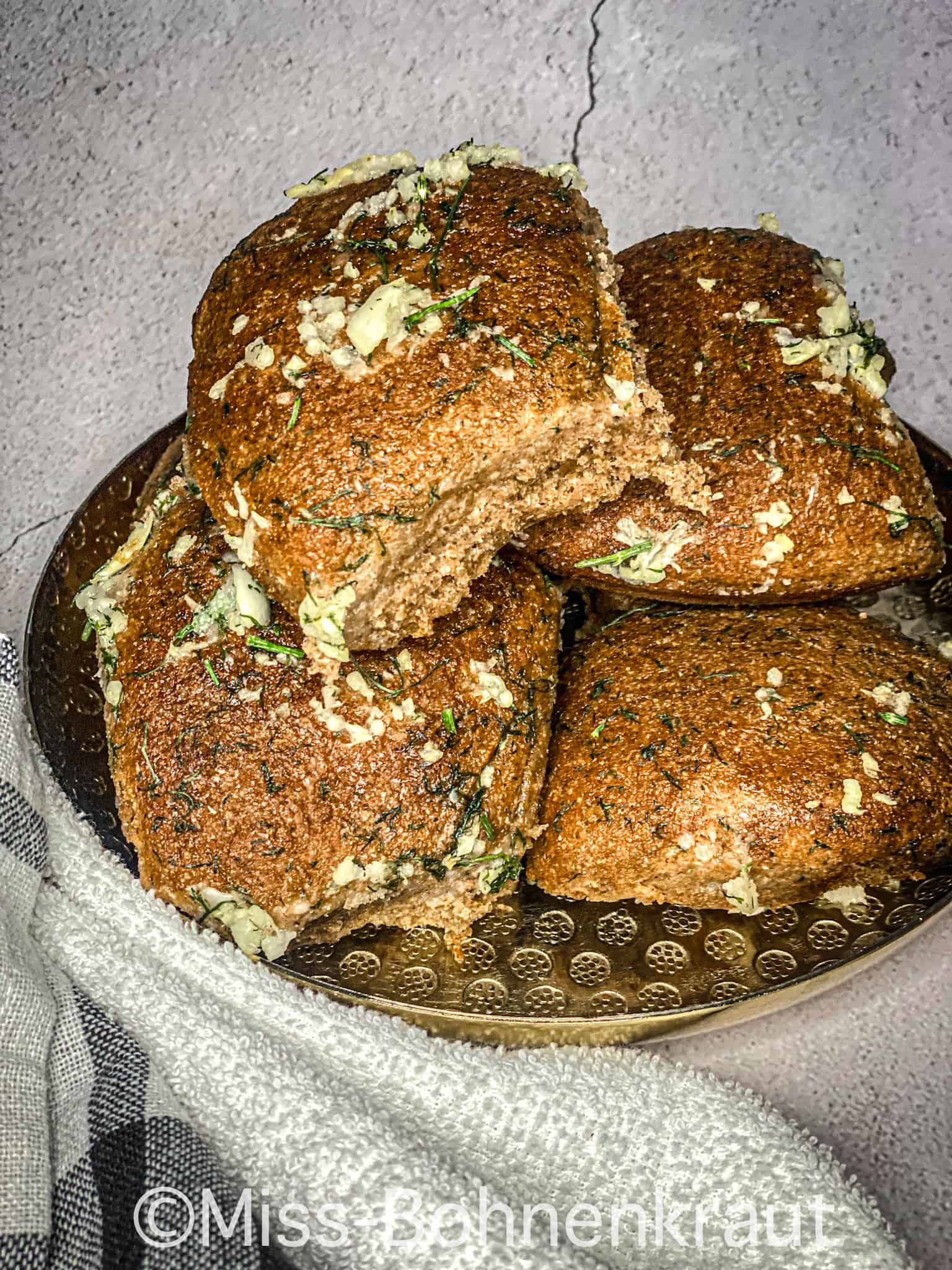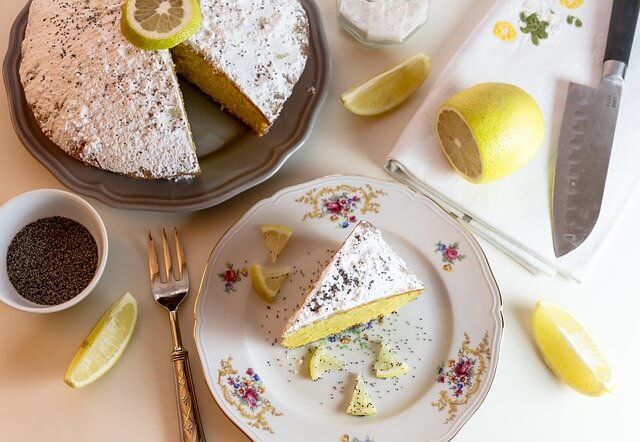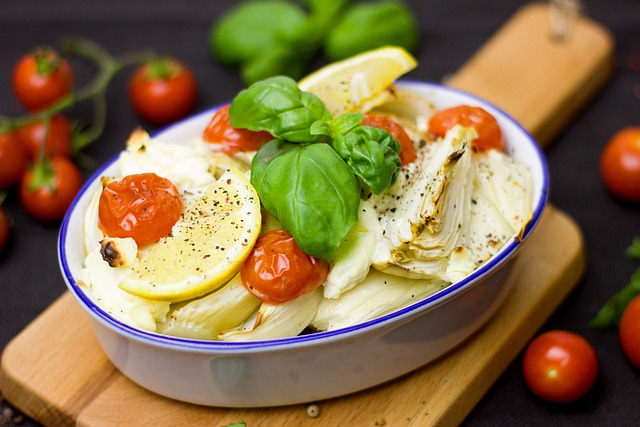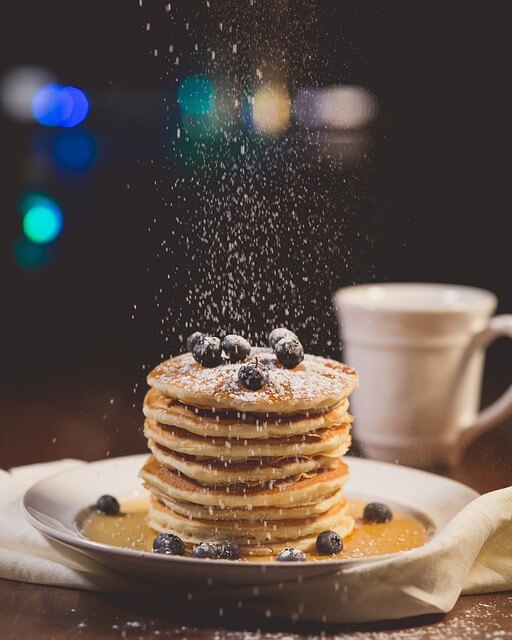These delicious Urkrainian Pampuschki taste so fluffy and so incredibly delicious thanks to the unique garlic taste.
Also see here why baking bread with fresh yeast is a good choice! In addition, this delicious solyanka goes perfectly with it.
Urkain Pampuschki – little story
Pampuschki are soft yeast rolls that are doused with garlic broth. They are considered a national dish in Ukrainian cuisine, but presumably have their origins in Germany.
In Cyrillic they are written пампушки. The singular is pampuschka, which is actually a trivialization.
The dish is known far beyond the Ukrainian border, especially due to the emigration of many Ukrainian families to Poland and the USA. The translated names are very similar, for example in Poland they are called pampuchy.
The thick, American pancakes and pancakes in German-speaking countries are also inspired by the pampuschky. In Germany, this causes some confusion, since the sweet pastry is only called pancakes in Berlin and otherwise Berliner.
Pampuschki are usually served with borscht, a beetroot soup, but are also popular as an accompaniment to many other soups or with a sweet filling and are popular as a dessert without garlic.
The Ukrainian cuisine
Ukrainian cuisine has its origins in the old Slavic culinary tradition, but came into contact with other international cooking traditions early on.
This connection is particularly noticeable in the neighboring countries of Poland and Russia, but the traces left by Ukrainian emigrant families can also be found in Germany and very strongly in Canada and the USA.
People like to cook hearty and spicy dishes here, with lots of vegetables and garlic. An unusually large variety of fruit and vegetables is processed and the focus is traditionally on foods that Ukrainian families can grow in their own gardens and process themselves.
The variety of soups and especially vegetarian vegetable soups is also remarkable in the Ukrainian cuisine. This is one of the reasons why it is customary to always serve some freshly baked bread with the main meal, with white and brown bread being more common than brown bread.
The international stars of Ukrainian cuisine
The internationally most famous dishes are borscht, solyanka and vareniki. Solyanka is a tomato soup based on cucumber brine and enriched with meat, sausage and sauerkraut. Vareniki are savory or sweet filled dumplings, which are also considered a Ukrainian national dish.
Vareniki even play a central role in a Ukrainian story by Nikolai Gogol: In The Night Before Christmas they magically fly through the air, dip themselves in sour cream and land straight in your mouth.
Typical Ukrainian drinks
The main drinks in Ukraine are tea and mineral water. Water sources are very important in Ukraine and especially the proximity to churches is perceived as positive for the water.
Compote drinks are also very popular. These are not comparable to the fruit puree, which is referred to elsewhere as compote, but is a drink made from fruit canned with sugar. In rural areas it is also quite common to press your own fruit juice and to prepare compote drinks yourself.
What is known in German-speaking countries as a bread drink is very healthy. It is made from fermented bread and has a sour taste, but is very rich in vitamins, fiber and minerals, has a probiotic effect and is considered helpful in chronic skin diseases.
When it comes to alcoholic beverages, vodka is very common, but regional beers and wines are also slowly emerging and enjoying increasing popularity.
Ukrainian desserts
The Ukrainians usually sweeten with honey instead of sugar and process a lot of fruit into desserts or sweet cakes.
Some recipes have become firmly entrenched in traditional cuisine in the days of Soviet cuisine and bear a mixture of French and Ukrainian or Russian names, such as Baba au rhum. This is a yeast cake with sugar syrup and rum said to have been invented by a Polish king and duke of Lorraine.
Halva, a specialty from the Middle East and Central Asia and southern and eastern Europe that looks like nougat on the outside, has had a very exciting journey. Presumably spread by nomads and traders, it has developed and established its own variants in countless cooking traditions.
Basic pampushki recipe
For the buns:
- 100 ml of lukewarm water
- 150 ml lukewarm milk
- 30 grams of sugar
- 4 g yeast dry yeast or 12 g fresh yeast
- 450 g wheat flour (type 550)
- 1 pinch of salt
- 70ml sunflower oil
- 1 egg yolk
For the garlic bread:
- 1 tsp salt
- 4 tbsp sunflower oil
- 6 cloves of garlic
- 4 tbsp water
- 1/2 bunch of dill
Prepare:
Note: The milk and water should be at least room temperature and ideally hatchwarm to allow the yeast to work. Liquid that is too hot or too cold slows down the yeast process or, in the worst case, destroys it.
- Crumble the yeast in 50 ml milk and let it dissolve, add the sugar and let it rest for a moment. Mix the egg yolk with 1 tbsp milk and set aside.
- In the meantime, knead the flour, salt and oil with the remaining liquid. It is best to use a hand mixer with a dough hook.
- Add the yeast mixture to the dough and knead until you have a soft, pliable dough. You can recognize a perfect yeast dough by the fact that it does not stick to hands that are not floured and you no longer feel any knots or bumps in the dough when kneading by hand.
- Cover and let the dough rise in a warm place for 1 1/2 hours.
- Then knead the dough again until it is soft again.
- Form small balls of approx. 150g from the dough. More and smaller balls can also be formed.
- Grease a casserole dish, springform pan or tart pan well and place the balls next to each other in the pan so that they touch. Then let the balls rest covered for another 20 minutes.
- Spread the egg yolk and milk mixture generously over the surface of the balls and bake at 180 degrees (fan oven) for 30 minutes.
The garlic stock should be poured directly over the oven-warm rolls, so ideally start the preparation 10-15 minutes before the end of baking.
- Finely chop the dill and parsley
- Squeeze the garlic cloves
- Mix everything well with the water and oil and leave to stand for a few minutes
- After baking, spread the brew generously over the surface and allow to cool briefly. Then enjoy the Pampuschki warm.
Serving housewife style
Ukrainian housewives often break the buns apart right after baking and put them in a large bowl. Then drizzle or spread the garlic stock on all sides instead of just the top, so the stock can soak deep into the buns.
This intensifies the taste, but makes for very greasy hands when serving and eating.
In some regions, herb butter with less garlic is used instead of the garlic stock. This is placed in slices on the rolls so that they melt when served.
Dill, parsley or chives are sprinkled over the rolls as decoration.
Ukrainian herbal cuisine
Dill is used extensively in Ukrainian cuisine as it goes well with most savory dishes and enjoys ideal growing conditions in the country.
If you have a self-sufficient herb pot in the kitchen or even in the garden, you can also grow dill and garlic in the same pot or bed – the two complement each other fantastically and do not take up space, light or nutrients. It is best to plant the garlic and simply sprinkle the dill in between.

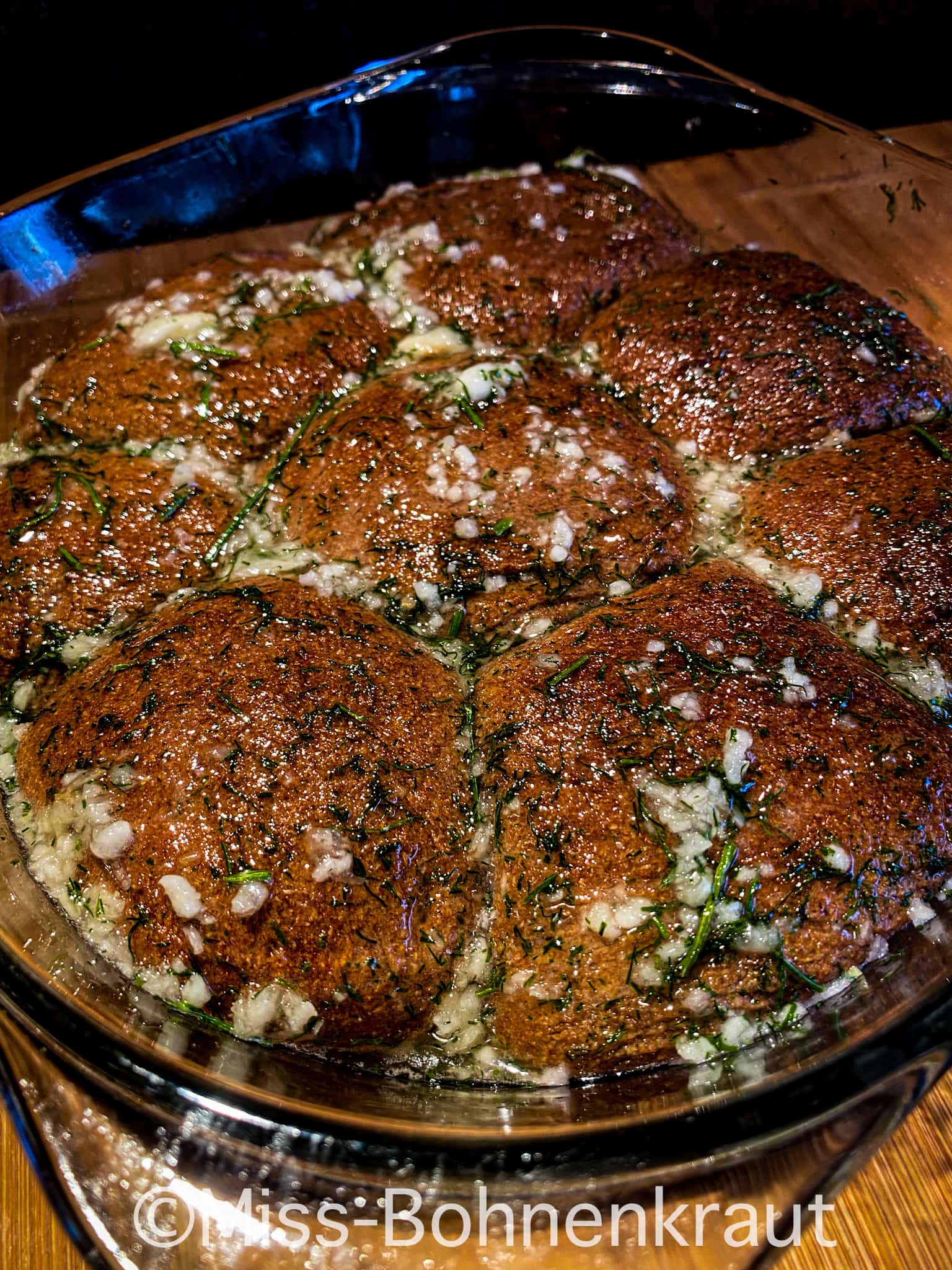
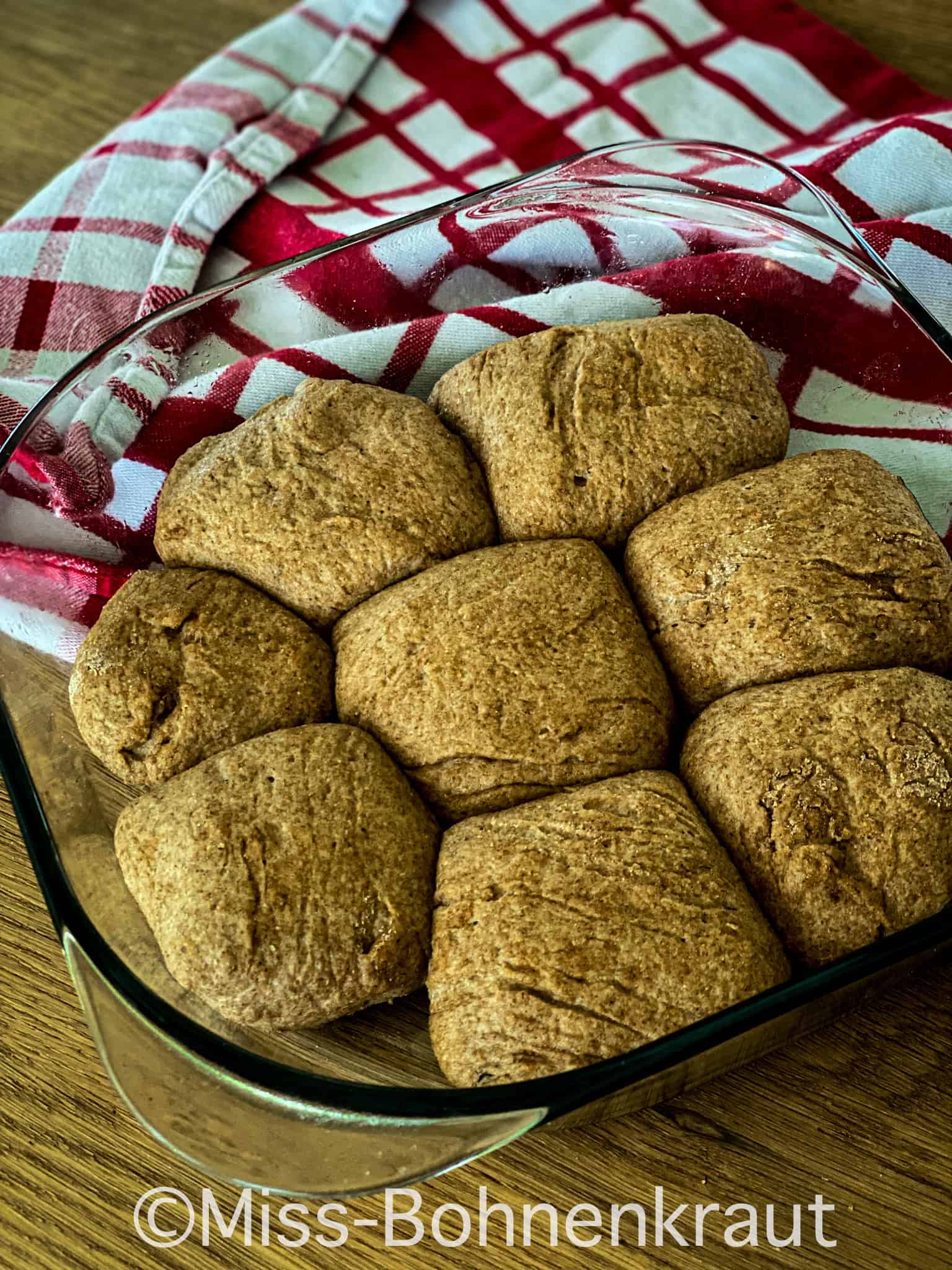
Ingredients for our Pampuschkis
For the dough you need:
- 500g wholemeal flour
- 300ml warm water
- 1 tsp salt
- 1 tablespoon sugar or sugar substitute (Xucker)
- 3 tbsp sunflower oil
- 7g dry yeast
Pampushki with a difference
Pampuschki are basically multifaceted and always adapt to the dish with which you serve them. This can be small changes in the herbs in the garlic stock or a surprising filling.
Pampuschki sees Ukrainian cuisine less as an independent and traditional recipe than as a basis for creative, individual variations.
Savory pampushki
In addition to the basic recipe you need:
- 1 onion
- 50 grams of bacon
- 1/2 zucchini
Finely dice the onion and sauté briefly with the bacon. Finely grate the zucchini. Put everything into the ready-to-bake yeast dough and knead well. Then proceed as usual.
These Pampuschki taste particularly good with soups that have less of a taste of their own or as a separate dish. Cooled, they are also great as a snack for trips!
For hot spirits, two chopped chili peppers can also be added.
Pampushki with herb quark
In addition to the basic recipe you need:
- 500 g low fat quark
- 1 clove of garlic
- 1 tsp lime juice
- 1/2 bunch of chives
- 1/2 bunch of dill
- 1/2 parsley
- 2 spring onions
- salt and pepper
Pampuschki can be dipped in fresh herb quark and eaten as an independent dish and quick dinner.
To do this, chop the herbs, press or chop the garlic, dice the onion and mix with the lime juice in the quark. Season with salt and pepper.
Sweet pampushki
Of course, this variant does not require garlic stock.
Instead, the balls are filled with a jam syringe or cut open after baking and filled by hand.
The traditional fillings are:
- berry jam
- plum jam
- yeah
- Varenye (jam-like fruit puree made in Eastern Europe)
- poppy seeds
They are strongly reminiscent of the yeast dumplings that are widespread in Austria and southern Germany and the related donuts or donuts mentioned above.
Coarsely chopped chocolate or frozen fruit can also be worked into the dough before baking.
Lactose-free or vegan Pampuschki
For lactose-free and vegan Pampuschki, only the milk has to be replaced 1:1 with a vegan alternative. Since these usually leave little taste of their own when baked, you can work with any kind, eg soy, nut or rice milk.
A mixture of vegan quark and a milk alternative or vegan soy yoghurt makes the dough even more airy.
The yolk can easily be replaced with olive or rapeseed oil. For sweet pampushki, it should be rapeseed or sunflower oil to avoid the harsh taste of olive oil.
Pampushki as an accompaniment to borscht
Pampushki and borscht are an absolute dream couple. Borscht is rarely served without Pampuschki, hence a short recipe for the delicious soup:
Ingredients:
- 2 carrots
- 1 onion
- 1 bedroot
- 1 bay leaf
- 1 tbsp butter
- 3 liters of water
- 500g beef soup meat
- 1 bunch of soup greens
- 1 tbsp flour
- 1 pinch salt & pepper
Prepare:
- Place the unpeeled beetroot in 1 liter of boiling water and simmer over low heat for 60 minutes. Then cool, peel and grate.
- Bring the beef to a boil with 2 liters of water and cook over medium-high heat, skimming off the foam.
- Wash and dice the soup vegetables and add to the meat soup with the bay leaf, salt and pepper. Let it cook for 2.5 hours.
- Remove the meat and pour the soup through a sieve and catch.
- Dice the onion and grate the carrots. Sauté both briefly in the butter, add the beetroot and the flour and heat for 2 minutes while stirring.
- Mix everything in a saucepan and let it simmer for 15 minutes on low heat.
There are many more variations in the preparation of Ukrainian buns. There is a classic recipe from the GDR and you can also fill these Ukrainian Pampuschki with feta, bacon and mozzarella . You can also prepare them in the Thermomix, for example as Pampuschki a la Thermiküche Maichingen.
Shelf life Ukrainian buns
Ukrainian rolls that have already been baked can easily be baked again the following day. If you really appreciate the garlic stock, you can pour new ones over the rolls.
You can freeze unbaked Pampuschki in portions. They should then be gently thawed in the refrigerator overnight. However, they don’t rise as well when baking and simply taste the best fresh.
Did you like the Pampuschkis recipe ?
I am really happy about your feedback on the Pampuschkis here in the comments. Be sure to tag me on Instagram with your cooked pictures. I’m really happy about that! I would always like to know how you succeeded with my recipe and how you liked it.
You are also welcome to save my recipe pictures on Pinterest and use them later or even repin them.
Are you still interested in more salad recipes? Try the tomato onion salad or the mixed salad with fresh herbs !
Step-by-step guide
step 1
Mix all ingredients together and set aside for about 1 hour.
step 2
Then roll out the dough and separate individual pieces. Then form small balls and place in a mold.
Now let it rise for another 15 minutes.
step 4
Then off in the oven and bake at 180 degrees for about 30 minutes
step 5
For the sauce:
1 – 2 cloves of garlic,
some dill,
some salt, 4 tablespoons of sunflower oil and 4 tablespoons of hot water
Mix all the ingredients of the herb sauce well and then pour over the hot Pampuschkis.
Then take the Pampuschkis out of the oven and brush them with the sauce
Now let’s cool and enjoy!
Bon Appetit!



